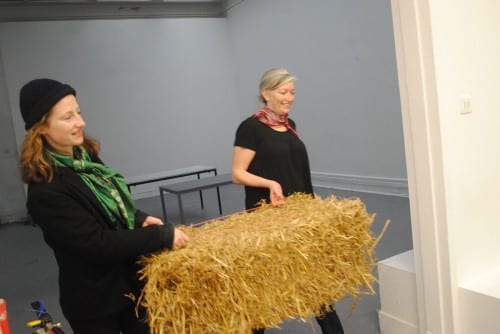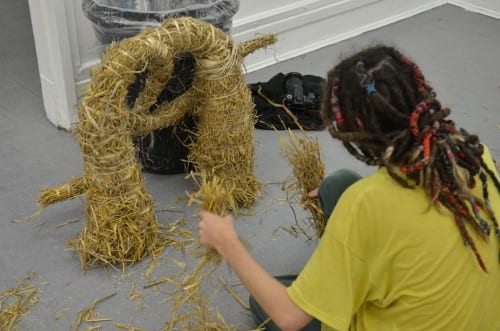Protima Workshop
By Susan Collins, on 25 November 2012
During my second visit to the Slade in June 2011, Susan suggested that I should conduct a making workshop at Slade. So far we had not considered this possibility as the Slade students are not used to being directed by tutors in this particular way. However, Professor John Aiken had seen traditional clay icons of the Hindu goddess of wisdom in Dhaka and had found them fascinating, thus Susan had the idea that we could perhaps have a traditional making workshop based on the icon making process.
This was a considerable change from the beginning where we had not thought that a making workshop of this kind would be of interest to the Slade students. I was also asked to deliver a lecture on Bangladeshi art for the Contemporary Art Lecture Series at Slade. I should mention here that Rafiqun Nabi, Dean and Professor, Painting Department, Shishir Bhattacharjee, Associate Professor, Painting Department, Nasimul Khabir and Nasima Haq Mitu, Lecturers, Sculpture Department also visited the Slade for the exchange. Shishir Bhattacharjee delivered a lecture on his own work while Nasima Haq Mitu and I jointly conducted the traditional making workshop. I felt that the Bangladeshi presence at the Slade, which has a very international ambience, gradually built up and invoked interest through the exchange and also through Susan’s enthusiasm and efforts. Many faculty members and students turned up for my lecture which was followed by an interesting question and answer session.
The workshop playfully titled “Hay, Clay” by the participating students was a very fulfilling experience. The students were committed, attentive, serious and very definite. They showed deep interest and curiosity about Bangladesh and our institution and wanted to visit as exchange students. We were comfortable to the point where we could almost relate to them as our students! This workshop was Susan’s idea to make the exchange more even on both sides. It made a world of difference to be in direct contact with students.
Lala Rukh Selim
The Bangladesh icon making workshop was the perfect culmination to the series of visits to the Slade by our colleagues in Dhaka. It was very important for us that there was an opportunity for equal exchange. I had been very excited about the folk art on my visit in 2010, both in terms of the paintings and also the large constructed, painted objects, so when John Aiken returned from his visit to Dhaka in February 2011 with a powerful set of photographs documenting the constructions and sculpted objects of the festival of the Goddess of Knowledge the idea for staging this workshop in London took hold.
The impact of the workshop was felt long before Lala Rukh and Nasima Haq Mitu arrived in London. Our Studio Manager Alan Taylor was tasked with finding all the items needed for it (most of which are every day, affordable items in Dhaka) and some samples were sent back to London with Lisa Milroy. Trying to match ‘sticky clay’ or ‘sandy clay’ to what might be available from specialist ceramic suppliers in London meant that Alan embarked on a sometimes very entertaining journey of discovery. Sticky clay it turned out is quite particular and sourced from the riverbeds of Bangladesh. Alan found the closest match he could – and we all exhaled when Lala Rukh and Mitu declared that it would work. The hay was eventually found at a city farm and arrived as we all expected it to, in neatly trimmed bales. Apparently this is not at all how it appears in Bangladesh, where the hay is left longer, untrimmed. British cows apparently are lazier than Bangladeshi ones. Lala Rukh and Mitu did their best with the materials we could provide, bringing the ones that they knew would be harder for us to source with them (tamarind seed for the glue, and special pigments).
Susan Collins
The best thing about the workshop was to meet Lala Rukh and Mitu. They are wonderful, centred and inspiring women and have a different story to tell about art school. A workshop environment, exploring new materials together was a very valuable experience, a model of how collective learning and exchange could be increased and encouraged at British art schools. It was exciting to see how everyone dared to let go of their inhibitions and concepts and let the methods lead the work. I am interested to learn more about the art school in Dhaka and wish there was an exchange programme for students to go and visit the Bangladesh. I think this would broaden our understanding of what art practice can be.
Babette Semmer, Painting, BA 3
I thoroughly enjoyed the Bangladeshi making work shop, it not only allowed me to learn new skills, it encouraged me as a painter to think more three dimensionally. I already make objects which go on the wall but this was my first time to make something free standing and it was really nice to do it in a workshop. I benefited not only from the experience of working with Lala and Mitu but also working with a range of different students from across the departments and meeting different tutors who popped by to say hi because they had been to Bangladesh. It was nice to make something in three days and the show at the end, inspired by Susan Collins, made it even more special. Thank you for organizing such a wonderful experience!
Sarah Pettit, Painting, MA 2
The workshop was in itself a highly enjoyable experience. It seemed to take me somewhere else then the art institution – it may have been the smell of hay or the traditional dresses that our tutors Lala and Mitu wore when they welcomed us. The atmosphere was also very cooperative as we needed to work together to move many kilograms of clay and bales of hay, and prepare the materials. It was physical, messy and a bit like being a kid again but at the same time everyone was committed to making the most out of the opportunity.
Working so closely together allowed me to have new dialogues and make friends from other courses at the Slade. The instruction was very well structured, fast paced and with clearly defined activities. There was a certain rigidity to the stages of making the sculptures which pacified my internal art critic and gave meafreedomtoexploretheprocessinitself. Even the decorating stage involved using unusual bright pigments, which meant that the final sculptures had different aesthetics to what we would normally see in the studios. There has been a lot of positive response and genuine interest generated by both the works and the uniqueness of the process. Finally, I enjoyed the opportunity to have a number of conversations about the Bangladeshi art and influences of tradition on contemporary perspectives.
Anja Borowicz, Sculpture, MA 2
The workshop was extremely hands on, engaging and indulgent. It is a process widely used in Bangladesh, but completely unfamiliar to us. Clay is a material we are all acquainted with, but using bamboo, hay, raw jute, tamarind glue and natural pigments were new. It was a privilege to have the freedom to experiment with them and be able to incorporate works made with them into my practice. I worked on a colonial bollard that fit in with my research on post colonialism. The fact that it was made of all natural materials which when put into a body of water will dissolve was a process that interested me most. It was exciting to learn a way to make sculpture where the process and its shape are never the same at two different times. It keeps on altering. The outcome was a successful one, the bollard surprisingly, still standing. It was good to know that I can put it into the water at a time that suits me and until then it will remain strong. I come from India, but even though we belong to the same continent, the culture in Bangladesh is different in many ways. It was exciting to learn about how this process of making came to be, why it was useful and the meaning behind its usage today for ritualistic prayer services.
Ayesha Singh, Sculpture, BFA 3
 Close
Close





